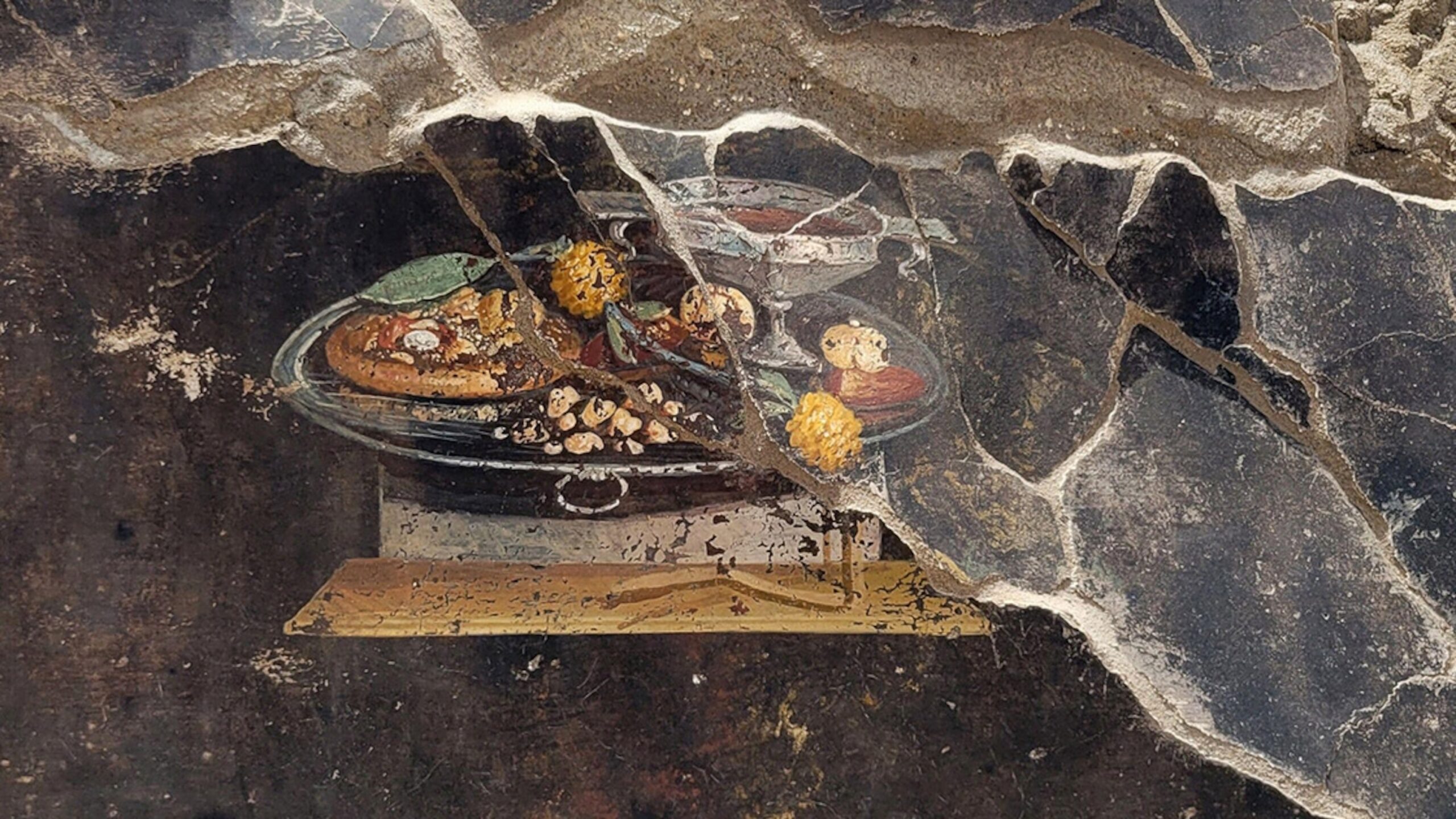When archaeologists in Pompeii found an virtually 2,000-year-old fresco of what’s being known as a “proto-pizza” in June, folks practically misplaced their minds. Whereas the flat piece of bread might need had meats, greens, or fruits on high, it was lacking the defining ingredient of a pizza: tomatoes.
The savory fruit wouldn’t make its option to Europe till the sixteenth century, lengthy after Mount Vesuvius erupted and decimated the traditional Roman cities of Pompeii and Herculaneum in 79 A.D. Pizza as we all know it wouldn’t be invented in Naples till the 18th century.
Whereas residents of Pompeii didn’t eat pizza, archaeologists and historians have pieced collectively a lot of what they did dine on, together with, umami-rich condiments, stuffed dormice, and an early ancestor of lasagna.
These discoveries are a part of what make Pompeii such a singular and necessary archaeological website. Though Vesuvius’ eruption is estimated to have been 100,000 occasions extra highly effective than the atomic bombs dropped on Japan throughout World Struggle II, the town wasn’t burned by lava and destroyed. As a substitute, a large cloud of scalding gasoline and ash enveloped it virtually instantly, carbonizing and preserving a lot of the natural matter, together with meals, in accordance with Alessando Russo, an archaeologist with the Pompeii Archaeological Park.
(These discoveries supply new clues to the destruction of Pompeii.)
Residents of the town additionally had no time to evacuate and died all of the sudden—inside quarter-hour, in accordance with one examine. Facial expressions are even seen on a number of the our bodies which have been unearthed. However their sudden deaths imply archaeologists have been capable of study extra about their on a regular basis duties like cooking and consuming. In 1930, for instance, a wonderfully preserved loaf of bread, indented with reed or string to interrupt aside extra simply, was present in an oven in Herculaneum.
“For these causes, Pompeii is a unicorn on this planet of archaeology,” Russo says.
Pompeii’s love for umami
Considered one of Pompeii’s hottest meals was an early ancestor of one other beloved meals: umami. The Japanese phrase, referring to the wealthy and savory fifth style, manifested in a fish-based sauce or condiment known as garum in Pompeii.
It’s salty and a little bit spicy, and Pompeiians, wealthy and poor, put it on every thing—like “historic ketchup,” as archaeobotanist Chiara Comegna places it. She works for Ales, an organization inside Italy’s Ministry of Tradition devoted to the dialog of the nation’s cultural heritage.
Taste-wise, nevertheless, garum is much like Thai or Vietnamese fish sauce, in accordance with the Pompeii Meals and Drink Mission, a coalition of historians, archaeologists, engineers, and volunteers that helped unearth and examine the meals of the town from 2001 till 2019.
“Think about in case your food plan, significantly in case you’re a poor particular person, is simply grits daily. What is going to you do to boost that meal and enhance the dietary content material?” says Benedict Lowe, a professor of historical past on the College of North Alabama, who served on the Pompeii Meals and Drink Mission. “You add garum. It’s spicy, it is pungent. But it surely’s protein-rich.”
(Re-creating the two,000-year-old bread present in Pompeii.)
The garum produced in Pompeii was notable for its high quality. To make it, folks would ferment fish—usually boop boop, a species of sea bream also referred to as bogue—in salt and typically different spices for so long as three months. Because the flesh decomposes, the bones sink, leaving a liquid, the garum, on high.
“When [vats of garum] had been excavated, you might nonetheless odor the aroma,” says Lowe, who analyzed the chemical composition of the sauce with a colleague in 2009 and found its similarity to umami. “I’ve a pattern of it …. And each time I open it, it stinks the room out as a result of the pungent aroma of this salted anchovy is so terrible.”
Delicacies of Pompeii
Proof of what Pompeiians ate has been found carbonized, however recipes, written on papyrus and translated by monks within the Center Ages, additionally supply clues, in accordance with Comegna. One recipe detailed what Comegna known as an “ancestor of lasagna.”
“No tomatoes, simply with meat and ricotta cheese, and layers of pasta,” Comegna mentioned. “Lasagna is the fashionable identify, though the thought is sort of the identical.”
One other dish—largely a delicacy for the wealthy—was stuffed dormouse, a bigger and meatier ancestor of recent mice. The dwell dormice can be positioned in a glirarium, a ceramic jar with a lid and perforations that allowed them to breathe. It was usually stuffed with nuts so they might eat, fatten up, after which be cooked.
“In response to the cookbook written by Apicius, the dormice can be full of pork, pepper, pine-nuts, and fish-sauce,” Lowe mentioned.
Regardless of literary proof that the higher lessons dined on flamingoes, no discoveries have verified that but, says Lowe. (He additionally cautions towards taking literature from the interval actually as a result of it was largely written by senators and different members of the higher class, who had a vested curiosity in portraying their society in probably the most constructive gentle doable.)
In 2005, researchers on the archaeological website recreated lots of the recipes of historic Pompeii and replanted a number of the vegatables and fruits residents ate, like figs, olives, plums, and grapes. (Pompeiians additionally traded with North Africa for dates.) Guests to the park might get pleasure from dishes corresponding to savillum, a favourite dessert much like a cheesecake or custard; peaches with honey; and prosciutto.
(Contained in the plan to convey the ghostly metropolis of Pompeii again to life.)
On high of their garum consumption, Pompeiians’ food plan revolved closely round fish. In a single sewer in Herculaneum, 43 species of fish bones had been discovered, in accordance with Lowe. Residents additionally obtained their protein from sheep, rooster, lentils, and beans, Comegna says. Cereals, corresponding to oats and barley, had been additionally frequent.
Flavors of Pompeii
Nearly all of the meals in Pompeii had been bland. The traditional Romans had salt in abundance, however not many different flavors, so that they’d commerce with India for spices like cinnabar and pepper. The truth is, the Romans spent a lot cash on spices that Indians used Roman forex as their very own for a time, Lowe says.
However solely the wealthy might afford spices. Homes of the extraordinarily rich even had saltwater ponds proper subsequent to their eating rooms, which they might inventory with fish to catch proper earlier than a meal, in accordance with Lowe. He factors out that Seneca, a significant stoic thinker of the time, wrote considerably sarcastically {that a} Roman wouldn’t contemplate a fish contemporary except they killed it on their plate.
In response to Comegna, the folks of Pompeii additionally flavored their wine—and adjusted its shade—utilizing fava beans. At one remarkably well-preserved “thermopolium,” a snack or wine bar, totally unearthed in 2020, fava beans had been discovered on the backside jugs of wine.
How—and the place—Pompeiians ate
Thermopolia stalls had been primarily the fast-food joints of yore. Pompeii has roughly 80 of those counters, the place residents, primarily employees, would cease for a small, scorching lunch or to select up groceries for dinner, Lowe says.
Along with wine, there’s proof they served snails, geese, pigs, goats and fish, in containers inlaid proper into the counter.
Since no utensils have been present in Pompeii, Lowe says their meals probably consisted of finger meals. Small bites even have been extra handy since Pompeiians ate mendacity down on eating couches, which have been unearthed at a number of properties within the metropolis. Pompeiians did have some spectacular serveware although, like intricate bowls comprised of terracotta and coloured glass pitchers.
(Pizza Margherita could also be match for a queen, however was it actually named for one?)
Nobody ate breakfast, except for the occasional gluttonous emperor, and lunch was usually sparse. Pompeiians, particularly the rich, saved all their room for dinner. Ladies would have eaten a modest night meal with their households. However males—particularly the rich—held ostentatious dinner celebrations, which might begin round three or 4 within the afternoon and typically final till the early hours of the morning.
“When you had been making an attempt to be morally upright, it might wrap up at nightfall or early night,” Lowe says. “You simply ate and ate [for] 10 programs, and also you eat till you are sick. You make your self throw up, and then you definately keep it up consuming.”










